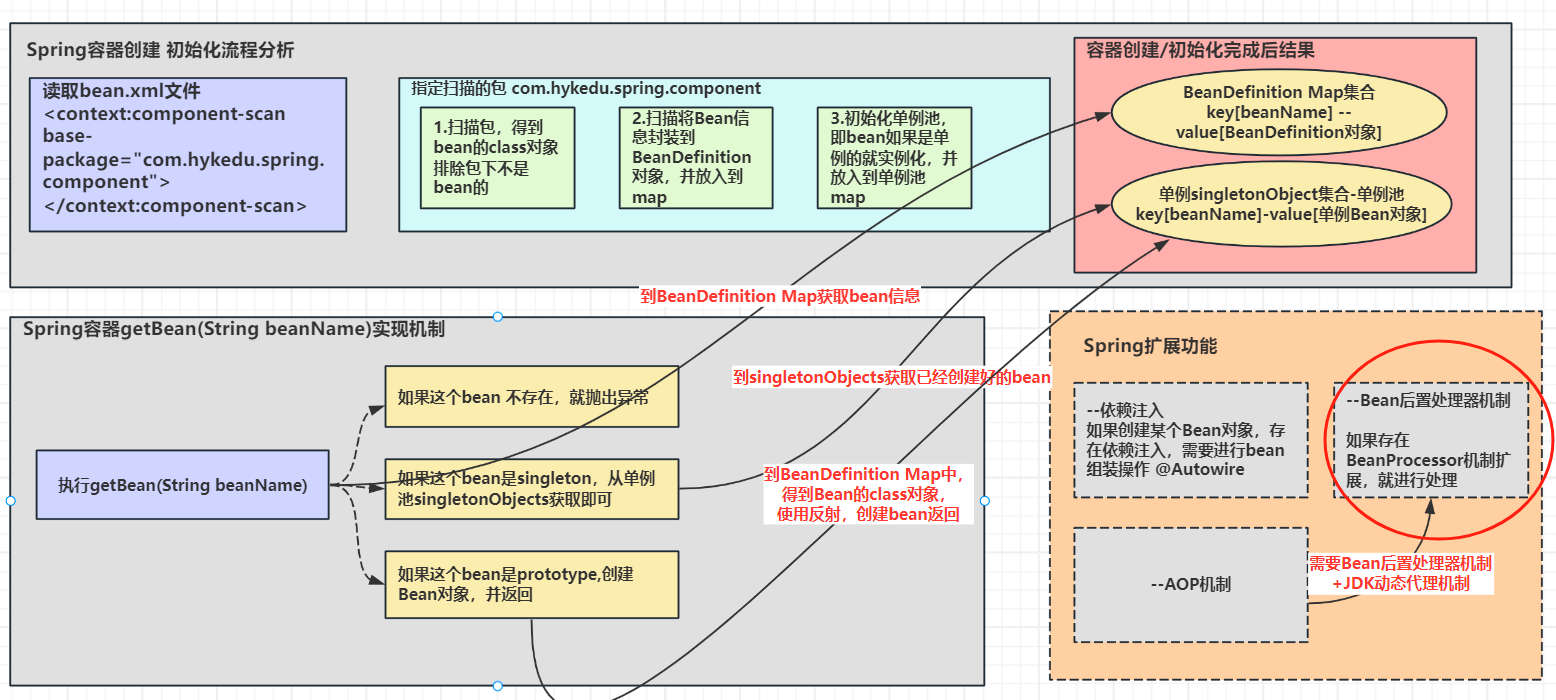手动实现 Spring 底层机制【初始化 IOC容器+依赖注入+BeanPostProcessor 机制+AOP】 【任务阶段5】
任务阶段1-4链接
一、实现任务阶段 1- 编写自己 Spring 容器,实现扫描包, 得到 bean 的 class 对象
二、实现任务阶段 2- 扫描将 bean 信息封装到 BeanDefinition 对象, 并放入到 Map
三、实现任务阶段 3- 初始化 bean 单例池,并完成 getBean 方法 , createBean 方法
四、实现任务阶段 4- 完成依赖注入
五、实现任务阶段 5- bean 后置处理器实现

1.在processor包定义InitializingBean接口
实现该接口的 Bean , 需要实现 Bean 初始化方法, 可以参考 原生 Spring 规范来定义这个接口
package com.hykedu.spring.processor;
/**
* @author 程序员蛇皮
* @version 1.0
* 1.我们根据原生Spring 定义了一个InitializingBean
* 2.该 InitializingBean接口有一个void afterPropertiesSet() throws Exception;
* 3.afterPropertiesSet() 在bean的setter后执行,即等价于Spring原来的初始化方法init()
* 4.当一个Bean实现这个接口后,就实现afterPropertiesSet(),这个方法就是初始化方法
*/
public interface InitializingBean {
void afterPropertiesSet() throws Exception;
}
2.编辑CodeSnakeSpringApplicationContext类的createBean(BeanDefinition beanDefinition)方法,在创建好 Bean 实例后,判断是否需要进行初始化 【 容器中常用的一个方法是,根据该类是否实现了某个接口,来判断是否要执行某个业务逻辑, 这里其实就是 java 基础的接口编程实际运用】
//完成createBean(BeanDefinition beanDefinition)方法
private Object createBean(BeanDefinition beanDefinition, String beanName) {
//得到Bean的clazz对象
Class clazz = beanDefinition.getClazz();
try {
//使用反射得到对象实例
Object instance = clazz.getDeclaredConstructor().newInstance();
//依赖注入
//1.遍历当前要创建的对象的所有字段
for (Field declaredField : clazz.getDeclaredFields()) {
//2.判断这个字段是否有@Autowired
if (declaredField.isAnnotationPresent(Autowired.class)) {
//3.得到这个字段的名字
String name = declaredField.getName();
System.out.println("字段名:" + name);
//4.通过getBean()获取要组装的对象
Object bean = getBean(name);
//5.进行组装
//私有属性需要进行反射暴破
declaredField.setAccessible(true);
declaredField.set(instance, bean);
}
}
System.out.println("------------------------------------------------------------------------------------------------------------------------------------------------");
System.out.println("=====创建好实例=====" + instance);
//这里要判断是否要执行Bean的初始化方法
//1.判断当前创建的Bean对象是否实现了InitializingBean
//2.实现了InitializingBean就调用初始化方法
if (instance instanceof InitializingBean) {
try {
((InitializingBean) instance).afterPropertiesSet();
} catch (Exception e) {
throw new RuntimeException(e);
}
}
if (instance != null) {
return instance;
}
} catch (Exception e) {
throw new RuntimeException(e);
}
return null;
}
3.测试:在StudentService类中实现InitializingBean接口并重新初始化方法
package com.hykedu.spring.component;
import com.hykedu.spring.annotation.Autowired;
import com.hykedu.spring.annotation.Component;
import com.hykedu.spring.annotation.Scope;
import com.hykedu.spring.processor.InitializingBean;
/**
* @author 程序员蛇皮
* @version 1.0
*/
@Scope(value = "prototype")
@Component
public class StudentService implements InitializingBean {
//这里我们使用自己的 @Autowired 来修饰属性
//表示该属性,是通过容器完成依赖注入
//我们这里实现按照名字进行组装
@Autowired
private StudentDao studentDao;
public void m1(){
studentDao.hi();
}
@Override
public void afterPropertiesSet() throws Exception {
System.out.println("StudentService初始化方法");
}
}
测试方法AppMain
package com.hykedu.spring;
import com.hykedu.spring.component.StudentDao;
import com.hykedu.spring.component.StudentService;
import com.hykedu.spring.ioc.CodeSnakeSpringApplicationContext;
import com.hykedu.spring.ioc.CodeSnakeSpringConfig;
/**
* @author 程序员蛇皮
* @version 1.0
*/
public class AppMain {
public static void main(String[] args) {
CodeSnakeSpringApplicationContext codeSnakeSpringApplicationContext = new CodeSnakeSpringApplicationContext(CodeSnakeSpringConfig.class);
StudentDao studentDao1 = (StudentDao) codeSnakeSpringApplicationContext.getBean("studentDao");
StudentDao studentDao = (StudentDao) codeSnakeSpringApplicationContext.getBean("studentDao");
StudentService studentService1 = (StudentService) codeSnakeSpringApplicationContext.getBean("studentService");
StudentService studentService2 = (StudentService) codeSnakeSpringApplicationContext.getBean("studentService");
System.out.println("ok");
}
}
测试结果:实现了InitializingBean接口的对象都在创建好实例后执行了初始化方法

4.在processor包定义后置处理器BeanPostProcessor接口
package com.hykedu.spring.processor;
/**
* @author 程序员蛇皮
* @version 1.0
* 1.参考原生Spring容器,定义一个BeanPostProcessor接口
* 2.该接口有两个方法 postProcessBeforeInitialization(Object bean, String beanName)、postProcessAfterInitialization(Object bean, String beanName)
* 3.这两个方法会对Spring容器的所有Bean生效
*/
public interface BeanPostProcessor {
/**
* 1.postProcessBeforeInitialization在Bean的初始化前调用
* @param bean
* @param beanName
* @return
*/
default Object postProcessBeforeInitialization(Object bean, String beanName) {
return bean;
}
/**
* 1.postProcessAfterInitializatio在Bean的初始化后调用
* @param bean
* @param beanName
* @return
*/
default Object postProcessAfterInitialization(Object bean, String beanName) {
return bean;
}
}
5.在component包中定义MyProcessor类,该类实现了BeanPostProcessor接口,重写其中的方法
package com.hykedu.spring.component;
import com.hykedu.spring.annotation.Component;
import com.hykedu.spring.processor.BeanPostProcessor;
import java.lang.reflect.InvocationHandler;
import java.lang.reflect.Method;
import java.lang.reflect.Proxy;
/**
* @author 程序员蛇皮
* @version 1.0
* 1.这是我们自己的一个后置处理器
* 2.实现了BeanPostProcessor
* 3.我们可以重新before和after
* 4.在Spring容器中,仍然把MyBeanPostProcessor当作一个Bean对象,注入到容器中
* 5.@Component
*/
@Component
public class MyBeanPostProcessor implements BeanPostProcessor {
@Override
public Object postProcessBeforeInitialization(Object bean, String beanName) {
System.out.println("后置处理器postProcessBeforeInitialization()被调用 bean类型=" + bean.getClass() + " bean的名字=" + beanName);
return bean;
}
@Override
public Object postProcessAfterInitialization(Object bean, String beanName) {
System.out.println("后置处理器postProcessAfterInitialization()被调用 bean类型=" + bean.getClass() + " bean的名字=" + beanName);
return bean;
}
}
6.编辑CodeSnakeSpringApplicationContext类的scanBeanDefinition(Class configClass)和createBean(BeanDefinition beanDefinition)方法,在我们Bean的初始化方法前,调用后置处理器的before方法,在我们Bean的初始化方法后,调用后置处理器的after方法
package com.hykedu.spring.ioc;
import com.hykedu.spring.annotation.Autowired;
import com.hykedu.spring.annotation.Component;
import com.hykedu.spring.annotation.ComponentScan;
import com.hykedu.spring.annotation.Scope;
import com.hykedu.spring.processor.BeanPostProcessor;
import com.hykedu.spring.processor.InitializingBean;
import org.apache.commons.lang.StringUtils;
import java.io.File;
import java.lang.reflect.Field;
import java.net.URL;
import java.util.ArrayList;
import java.util.List;
import java.util.concurrent.ConcurrentHashMap;
/**
* @author 程序员蛇皮
* @version 1.0
* SpringApplicationContext 类的作用类似Spring原生ioc容器
*/
@SuppressWarnings("all")
public class CodeSnakeSpringApplicationContext {
private Class configClass;
//定义beanDefinitionMap,存放BeanDefinition对象
private final ConcurrentHashMap<String, BeanDefinition> beanDefinitionMap = new ConcurrentHashMap<>();
//定义singletonObjects,存放单例对象
private final ConcurrentHashMap<String, Object> singletonObjects = new ConcurrentHashMap<>();
//定义beanPostProcessors=>存放后置处理器
private final List<BeanPostProcessor> beanPostProcessors = new ArrayList<>();
public CodeSnakeSpringApplicationContext(Class configClass) {
scanBeanDefinition(configClass);
scanSingletonObjects();
}
//初始化单例池方法
private void scanSingletonObjects() {
//通过 beanDefinitionMap,初始化 singletonObjects 单例池
ConcurrentHashMap.KeySetView<String, BeanDefinition> keys = beanDefinitionMap.keySet();
for (String key : keys) {
BeanDefinition beanDefinition = beanDefinitionMap.get(key);
//判断该bean是singleton还是prototype
if ("singleton".equalsIgnoreCase(beanDefinition.getScope())) {
Object bean = createBean(beanDefinition, key);
singletonObjects.put(key, bean);
}
}
}
//该方法完成的对指定包的扫描,并将Bean信息封装到BeanDefinition对象,再放入map
private void scanBeanDefinition(Class configClass) {
this.configClass = configClass;
System.out.println(configClass);
//获取要扫描的包
//1.先得到SpringConfig配置的@ComponentScan(value = "com.hykedu.spring.component")
ComponentScan componentScan = (ComponentScan) this.configClass.getDeclaredAnnotation(ComponentScan.class);
//2.componentScan的value就是我们要扫描的包
String path = componentScan.value();
System.out.println("要扫描的包:" + path);
//得到要扫描的包下所有的资源(类.class)
//1.得到类的加载器
ClassLoader classLoader = CodeSnakeSpringApplicationContext.class.getClassLoader();
//2.通过类加载器获取到要扫描包的url
path = path.replace(".", "/");//把 . 替换成路径间隔符 /
URL resource = classLoader.getResource(path);
System.out.println("要扫描包的url:" + resource);
//3.将要加载的资源(.class) 路径下的文件进行遍历=>io
File file = new File(resource.getFile());
if (file.isDirectory()) {//pand
File[] files = file.listFiles();
for (File f : files) {
String absolutePath = f.getAbsolutePath();
System.out.println("文件的绝对路径:" + absolutePath);
//这里我们只处理.class文件
if (absolutePath.endsWith(".class")) {
//1.获取到类名
String className = absolutePath.substring
(absolutePath.lastIndexOf("\\") + 1, absolutePath.lastIndexOf(".class"));
System.out.println("类名:" + className);
//2.获取类的完整路径(全类名)
String classFullName = path.replace("/", ".") + "." + className;
System.out.println("全类名:" + classFullName);
//3.判断该类是否需要注入容器,判断该类是不是有@Component/@Controller/@Repository/@Service注解
try {
Class<?> clazz = classLoader.loadClass(classFullName);
if (clazz.isAnnotationPresent(Component.class)) {
//如果在注解指定了value,将其赋值给className
System.out.println("这是一个Spring bean" + clazz);
//1.这里为了方便,将后置处理器放入到ArrayList集合中
//2.如果发现是一个后置处理器,放入到beanPostProcessors
//3.在原生的Spring中,对后置处理器还是走的getBean,createBean,但是我们需要在singletonObjects加入相应的业务逻辑
//4.这里我们简化,用的ArrayList
//判断这个clazz有没有实现BeanPostProcessor
//说明:这里我们不能使用 instanceof 来判断clazz是否实现了BeanPostProcessor
//原因:clazz不是一个实例对象,而是一个类对象/clazz
if (BeanPostProcessor.class.isAssignableFrom(clazz)) {
BeanPostProcessor beanPostProcessor = (BeanPostProcessor) clazz.newInstance();
beanPostProcessors.add(beanPostProcessor);
continue;
}
Component componentAnnotation = clazz.getDeclaredAnnotation(Component.class);
String beanName = componentAnnotation.value();
if (beanName.equals("")) {
//将类名首字母小写作为beanName
beanName = StringUtils.uncapitalize(className);
}
BeanDefinition beanDefinition = new BeanDefinition();
beanDefinition.setClazz(clazz);
if (clazz.isAnnotationPresent(Scope.class)) {
//如果配置了Scope,获取他配置的值
Scope scopeAnnotation = clazz.getDeclaredAnnotation(Scope.class);
beanDefinition.setScope(scopeAnnotation.value());
} else {
//如果没有配置值,就默认Singleton
beanDefinition.setScope("singleton");
}
//将beanDefinition放入beanDefinitionMap
beanDefinitionMap.put(beanName, beanDefinition);
} else {
System.out.println("这不是一个Spring bean" + clazz);
}
} catch (Exception e) {
throw new RuntimeException(e);
}
}
}
}
}
//完成createBean(BeanDefinition beanDefinition)方法
private Object createBean(BeanDefinition beanDefinition, String beanName) {
//得到Bean的clazz对象
Class clazz = beanDefinition.getClazz();
try {
//使用反射得到对象实例
Object instance = clazz.getDeclaredConstructor().newInstance();
//依赖注入
//1.遍历当前要创建的对象的所有字段
for (Field declaredField : clazz.getDeclaredFields()) {
//2.判断这个字段是否有@Autowired
if (declaredField.isAnnotationPresent(Autowired.class)) {
//3.得到这个字段的名字
String name = declaredField.getName();
System.out.println("字段名:" + name);
//4.通过getBean()获取要组装的对象
Object bean = getBean(name);
//5.进行组装
//私有属性需要进行反射暴破
declaredField.setAccessible(true);
declaredField.set(instance, bean);
}
}
System.out.println("------------------------------------------------------------------------------------------------------------------------------------------------");
System.out.println("=====创建好实例=====" + instance);
//在我们Bean的初始化方法前,调用后置处理器的before方法
for (BeanPostProcessor beanPostProcessor : beanPostProcessors) {
Object current = beanPostProcessor.postProcessBeforeInitialization(instance, beanName);
if (current != null) {
instance = current;
}
}
//这里要判断是否要执行Bean的初始化方法
//1.判断当前创建的Bean对象是否实现了InitializingBean
//2.实现了InitializingBean就调用初始化方法
if (instance instanceof InitializingBean) {
try {
((InitializingBean) instance).afterPropertiesSet();
} catch (Exception e) {
throw new RuntimeException(e);
}
}
//在我们Bean的初始化方法后,调用后置处理器的after方法
for (BeanPostProcessor beanPostProcessor : beanPostProcessors) {
Object current = beanPostProcessor.postProcessAfterInitialization(instance, beanName);
if (current != null) {
instance = current;
}
}
if (instance != null) {
return instance;
}
} catch (Exception e) {
throw new RuntimeException(e);
}
return null;
}
//编写方法,返回容器的对象
public Object getBean(String name) {
if (beanDefinitionMap.containsKey(name)) {
BeanDefinition beanDefinition = beanDefinitionMap.get(name);
if ("singleton".equalsIgnoreCase(beanDefinition.getScope())) {
//说明是单例配置
return singletonObjects.get(name);
} else {//如果不是单例的,就反射一个新的对象
return createBean(beanDefinition, name);
}
}
throw new NullPointerException("没有该bean");
}
}
7.在AppMain中进行测试
测试结果:成功在初始化方法前后调用后置处理器方法






















 284
284

 被折叠的 条评论
为什么被折叠?
被折叠的 条评论
为什么被折叠?








